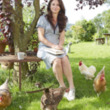The Summer Before the War: A Novel
(Libby/OverDrive eBook, Kindle)
Available Platforms
Description
More Details
Similar Titles From NoveList
Similar Authors From NoveList
Published Reviews
Booklist Review
In the summer of 1914, Beatrice Nash arrives in Rye, East Sussex, to teach Latin at the local school. Her scholar father having recently died, Beatrice is determined to remain a spinster (but we know how that goes) and find meaningful work and a productive life. Her patroness, Agatha Kent, is married to an official in the Foreign Office and presides over a household that includes two nephews sensible Hugh, completing his medical studies, and passionate Daniel, a poet. Other characters from up and down the social scale fill out the busy canvas landed gentry; a celebrated, Henry James-like author (James in fact lived in Rye at the time); a half-Gypsy boy whom Beatrice considers her best pupil; townspeople; country folk. The war begins to cast its shadow. Belgian refugees arrive, Hugh and Daniel enlist, and what starts out as a sprightly comedy of manners takes a turn into wartime tragedy. The shift may be a bit jarring, but this novel is just the ticket for fans of Simonson's debut, Major Pettigrew's Last Stand (2010), and for any reader who enjoys leisurely fiction steeped in the British past.--Quinn, Mary Ellen Copyright 2016 Booklist
Publisher's Weekly Review
Simonson's dense follow-up to the bestselling Major Pettigrew's Last Stand focuses on gender, class, and social mores in the town of Rye in Sussex, England, at the dawn of World War I. Following the death of her father, who raised her to be intelligent and worldly, writer Beatrice Nash looks forward to tutoring three boys in Latin before she begins her position at school in the fall. Her advocate is the shrewd Agatha Kent, a discreet progressive who's married to John, a senior official in the military. The childless couple love their grown nephews, Hugh Grange, who is destined to be a doctor, and Daniel Bookham, a handsome poet who hopes to move to Paris and start his own journal with a friend. As a woman, Beatrice doesn't have much clout, nearly losing her job to nepotism and being dismissed by her favorite author, her relatives, and her dad's publishing house. Simonson does a great job crafting the novel's world. It's a large book, and the plot takes its time to get going, but the story becomes engaging after Germany invades Belgium and Rye takes in refugees. Simonson's writing is restrained but effective, especially when making quiet revelations. A heartbreaking but satisfying ending seems fitting for a story about the social constructs that unfairly limit people and their potential. Agent: Julie Barer, Barer Literary. (Mar.) © Copyright PWxyz, LLC. All rights reserved.
School Library Journal Review
Among the throngs of Americans who devoted themselves to the British historical drama Downton Abbey are a respectable number of young adult enthusiasts. Those teens may have cut their teeth on print historical fiction and count themselves among the acolytes of Jane Austen or the Brontës. This novel's setting is not the grand estate, nor are its characters of the upstairs and downstairs dichotomy. Instead, it features progressive Beatrice Nash, newly arrived to Rye to take on a Latin teaching position. After the death of her scholarly father, she has found employment to gain independence from his family who control what money she has inherited. In Rye, she finds herself championed by Agatha Kent, a woman who would never count herself among the blue stockings but who is nonetheless a force in the town. Beatrice is welcomed by Agatha's two nephews, one a poet and one just finishing his training as a surgeon. Hugh, the doctor, is particularly kind to Beatrice as she faces challenges such as an unpleasant landlady, unscrupulous solicitors, and reluctant pupils. The German invasion of Belgium in 1914 heralds England's going to war and brings refugees, like the lovely blonde Celeste, whom Beatrice takes in. Like no summer before it, this last one before the Great War is revealed in the day-to-day lives of Miss Nash and her newly adopted neighbors. VERDICT A perfect choice for teens who enjoy detailed historical fiction and BBC television serials.-Suzanne Gordon, Lanier High School, Sugar Hill, GA © Copyright 2016. Library Journals LLC, a wholly owned subsidiary of Media Source, Inc. No redistribution permitted.
Library Journal Review
Schoolteacher Beatrice Nash is eager to start a new job teaching Latin in the small English seaside town of Rye in the summer of 1914. She soon has a front-row seat as local squabbles regarding such matters as whether a woman should be teaching Latin at all give way to the more pressing concerns of World War I. A group of refugees from Belgium throw the orderly lives of Rye's residents into tumult, and the town is soon asked to make even larger sacrifices as its sons depart for the front. VERDICT -Simonson's episodic descriptions of life in Rye as the war looms are a good bet for those looking for a relatively gentle World War I-era historical with a touch of romance. The book falters a bit when it switches away from Rye to cover life in the trenches, and the climax there feels a bit melodramatic, but -Simonson's good-hearted, likable characters make up for these weaknesses and will remind readers of those from her best-selling debut, -Major Pettigrew's Last Stand. [See Prepub Alert, 9/21/15.]-Mara Bandy, Champaign P.L., IL © Copyright 2016. Library Journals LLC, a wholly owned subsidiary of Media Source, Inc. No redistribution permitted.
Kirkus Book Review
A bright confection of a book morphs into a story of dignity and backbone. Simonson follows Major Pettigrew's Last Stand (2010), her charming debut, with another comedy of manners nestled in a British village. This time she deepens the gravitas and fattens the story, which begins on the cusp of World War I. Pettigrew fans will cheer to find romance mentioned on the second page and class snobbery on the fourth. The heroine, Beatrice Nash, quickly follows, aboard a train bound for coastal Rye and a job teaching Latin in the village grammar school. This itselfa woman teacher in 1914is a breach in tradition that foments small-town intrigue amid petticoats and decorated millinery. A pair of suffragettes mildly scandalizes the villagers, but Beatrice is more bedeviled by the politics of her financial dependency. An orphan at 23, she is self-aware but still green. Her patron, Agatha Kent, is bracketed by intriguing nephews Hugh Grange and Daniel Bookham, soon to be officers, and there is a smart local gypsy youth who stirs real feeling even as he lies to join the troops. Writing cleanly, Simonson has an observant eye and a comic touch, particularly in the person of a vainglorious American author, "swaying a little as the bulk of his torso sought equilibrium above two short legs and a pair of dainty feet." She complicates Rye with the arrival of Belgian refugees and sends the reader, alongside key menfolk, into the lethal Flemish trenches. An epilogue touches down in summer 1920. The novel starts slowlyit takes until Page 282 for Beatrice to reach the classroomand a few bromides clutter the denouement, but this book is beautifully plotted and morally astute. Even the callow American has his part to play. Aficionados of Downton Abbey and The Guernsey Literary and Potato Peel Pie Society will sigh with pleasure. Copyright Kirkus Reviews, used with permission.
Booklist Reviews
In the summer of 1914, Beatrice Nash arrives in Rye, East Sussex, to teach Latin at the local school. Her scholar father having recently died, Beatrice is determined to remain a spinster (but we know how that goes) and find "meaningful work and a productive life." Her patroness, Agatha Kent, is married to an official in the Foreign Office and presides over a household that includes two nephews—sensible Hugh, completing his medical studies, and passionate Daniel, a poet. Other characters from up and down the social scale fill out the busy canvas—landed gentry; a celebrated, Henry James-like author (James in fact lived in Rye at the time); a half-Gypsy boy whom Beatrice considers her best pupil; townspeople; country folk. The war begins to cast its shadow. Belgian refugees arrive, Hugh and Daniel enlist, and what starts out as a sprightly comedy of manners takes a turn into wartime tragedy. The shift may be a bit jarring, but this novel is just the ticket for fans of Simonson's debut, Major Pettigrew's Last Stand (2010), and for any reader who enjoys leisurely fiction steeped in the British past. Copyright 2014 Booklist Reviews.
Library Journal Reviews
If you liked Simonson's debut New York Times best seller (and best-booked) Major Pettigrew's Last Stand, you'll definitely go for her new work, which revisits the particularities of English town life. In summer 1914, well-bred Beatrice Nash arrives in Rye to become the first female Latin teacher at the local school and soon falls in love with her sponsor's nephew. All would be golden but for the terrible rumbling of coming war.
[Page 62]. (c) Copyright 2015 Library Journals LLC, a wholly owned subsidiary of Media Source, Inc. No redistribution permitted.Library Journal Reviews
Schoolteacher Beatrice Nash is eager to start a new job teaching Latin in the small English seaside town of Rye in the summer of 1914. She soon has a front-row seat as local squabbles regarding such matters as whether a woman should be teaching Latin at all give way to the more pressing concerns of World War I. A group of refugees from Belgium throw the orderly lives of Rye's residents into tumult, and the town is soon asked to make even larger sacrifices as its sons depart for the front. VERDICT Simonson's episodic descriptions of life in Rye as the war looms are a good bet for those looking for a relatively gentle World War I-era historical with a touch of romance. The book falters a bit when it switches away from Rye to cover life in the trenches, and the climax there feels a bit melodramatic, but Simonson's good-hearted, likable characters make up for these weaknesses and will remind readers of those from her best-selling debut, Major Pettigrew's Last Stand. [See Prepub Alert, 9/21/15.]—Mara Bandy, Champaign P.L., IL
[Page 73]. (c) Copyright 2016 Library Journals LLC, a wholly owned subsidiary of Media Source, Inc. No redistribution permitted.Publishers Weekly Reviews
Simonson's dense follow-up to the bestselling Major Pettigrew's Last Stand focuses on gender, class, and social mores in the town of Rye in Sussex, England, at the dawn of World War I. Following the death of her father, who raised her to be intelligent and worldly, writer Beatrice Nash looks forward to tutoring three boys in Latin before she begins her position at school in the fall. Her advocate is the shrewd Agatha Kent, a discreet progressive who's married to John, a senior official in the military. The childless couple love their grown nephews, Hugh Grange, who is destined to be a doctor, and Daniel Bookham, a handsome poet who hopes to move to Paris and start his own journal with a friend. As a woman, Beatrice doesn't have much clout, nearly losing her job to nepotism and being dismissed by her favorite author, her relatives, and her dad's publishing house. Simonson does a great job crafting the novel's world. It's a large book, and the plot takes its time to get going, but the story becomes engaging after Germany invades Belgium and Rye takes in refugees. Simonson's writing is restrained but effective, especially when making quiet revelations. A heartbreaking but satisfying ending seems fitting for a story about the social constructs that unfairly limit people and their potential. Agent: Julie Barer, Barer Literary. (Mar.)
[Page ]. Copyright 2016 PWxyz LLCSchool Library Journal Reviews
Among the throngs of Americans who devoted themselves to the British historical drama Downton Abbey are a respectable number of young adult enthusiasts. Those teens may have cut their teeth on print historical fiction and count themselves among the acolytes of Jane Austen or the Brontës. This novel's setting is not the grand estate, nor are its characters of the upstairs and downstairs dichotomy. Instead, it features progressive Beatrice Nash, newly arrived to Rye to take on a Latin teaching position. After the death of her scholarly father, she has found employment to gain independence from his family who control what money she has inherited. In Rye, she finds herself championed by Agatha Kent, a woman who would never count herself among the blue stockings but who is nonetheless a force in the town. Beatrice is welcomed by Agatha's two nephews, one a poet and one just finishing his training as a surgeon. Hugh, the doctor, is particularly kind to Beatrice as she faces challenges such as an unpleasant landlady, unscrupulous solicitors, and reluctant pupils. The German invasion of Belgium in 1914 heralds England's going to war and brings refugees, like the lovely blonde Celeste, whom Beatrice takes in. Like no summer before it, this last one before the Great War is revealed in the day-to-day lives of Miss Nash and her newly adopted neighbors. VERDICT A perfect choice for teens who enjoy detailed historical fiction and BBC television serials.—Suzanne Gordon, Lanier High School, Sugar Hill, GA. Copyright 2016 School Library Journal.
Reviews from GoodReads
Citations
Simonson, H. (2016). The Summer Before the War: A Novel . Random House Publishing Group.
Chicago / Turabian - Author Date Citation, 17th Edition (style guide)Simonson, Helen. 2016. The Summer Before the War: A Novel. Random House Publishing Group.
Chicago / Turabian - Humanities (Notes and Bibliography) Citation, 17th Edition (style guide)Simonson, Helen. The Summer Before the War: A Novel Random House Publishing Group, 2016.
Harvard Citation (style guide)Simonson, H. (2016). The summer before the war: a novel. Random House Publishing Group.
MLA Citation, 9th Edition (style guide)Simonson, Helen. The Summer Before the War: A Novel Random House Publishing Group, 2016.
Copy Details
| Collection | Owned | Available | Number of Holds |
|---|---|---|---|
| Libby | 10 | 8 | 0 |





































